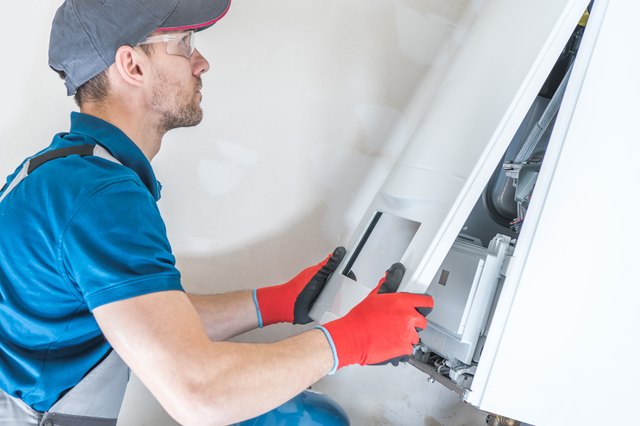During a frigid winter night, with the howling wind and snow blurring the vision outside, your home’s furnace suddenly decides to quit working, plunging you into an unexpected icy abyss. Don’t panic! Whether you’re a seasoned homeowner or a newbie in the world of home repairs, this comprehensive guide will equip you with the knowledge and confidence to troubleshoot and potentially fix your furnace, restoring warmth and comfort to your home.

Image: www.hunker.com
Understanding Your Furnace
A furnace is the heart of your home’s heating system, responsible for generating and distributing warm air throughout the house. Different types of furnaces exist, including gas, oil, and electric models. By understanding the basic functioning of your specific furnace, you can better pinpoint potential issues and embark on the repair journey.
Furnaces operate on the principle of heat exchange, transferring thermal energy from a fuel source (gas, oil, or electricity) to the air circulating inside the furnace. The heated air is then distributed through a network of ducts and vents, reaching various rooms in your home. As the air cools, it descends, completing the cycle and allowing for continuous heating.
Troubleshooting Common Furnace Problems
When your furnace malfunctions, it’s crucial to identify the root cause of the problem. Here are some of the most common furnace issues and their potential fixes:
No Power to the Furnace
- Check the circuit breaker or fuse box: Ensure that the circuit breaker controlling the furnace is not tripped or the fuse is not blown.
- Inspect the power cord: Make sure the power cord is securely plugged into an outlet and that it’s not damaged.

Image: www.fix.com
Pilot Light is Out
Gas furnaces have a pilot light that ignites the gas burner. If the pilot light goes out, the furnace will not generate heat.
- Relight the pilot light: Follow the manufacturer’s instructions for relighting the pilot light. This typically involves locating the pilot light assembly, pushing in the gas control knob, and igniting the gas with a lighter or match.
- Check the thermocouple or flame sensor: These components detect the presence of the flame and keep the gas valve open. If they are dirty or malfunctioning, the pilot light may not stay lit.
Dirty Filter or Airflow Obstruction
- Replace the air filter: A dirty air filter can restrict airflow, causing the furnace to overheat and shut off. Replace the filter regularly, typically once a month during the heating season.
- Check for airflow obstructions: Inspect the air intake and exhaust vents to ensure they are not blocked by debris or furniture.
Malfunctioning Thermostat
- Replace the batteries: Most thermostats require batteries to operate. If the batteries are low or dead, the thermostat may not be able to send signals to the furnace.
- Check the wiring: Ensure that the thermostat is properly wired and that the wires are not loose or damaged.
Safety Considerations
Before attempting any furnace repairs, it’s essential to prioritize safety:
- Turn off the power: Switch off the circuit breaker or fuse supplying power to the furnace at the main electrical panel.
- Allow the furnace to cool down: Furnaces can be extremely hot, so give it ample time to cool down before handling any components.
- Use proper tools: Employ the right tools for the job, such as a screwdriver, wrench, and multimeter. Ensure they are in good condition and insulated for electrical work.
- Avoid DIY repairs if gas is involved: Gas furnaces involve working with flammable gas, posing potential hazards. If you’re not confident or lack experience, it’s best to call a licensed HVAC technician.
Expert Tips and Advice
In addition to the troubleshooting steps above, here are some expert tips and advice to help you fix a furnace:
- Regular maintenance is key: Preventative maintenance, like changing the air filter and scheduling annual inspections, can extend the lifespan of your furnace and reduce the likelihood of unexpected breakdowns.
- Listen to unusual sounds: Pay attention to any strange noises coming from your furnace, such as rattling, humming, or banging. These sounds could indicate a loose component or potential damage.
- Check online resources: Utilize online forums, manufacturer’s websites, and YouTube videos for additional troubleshooting guidance and expert advice.
- Don’t hesitate to call a professional: If you’re not comfortable with DIY repairs or encounter a complex issue, don’t hesitate to contact a licensed HVAC technician for assistance.
FAQs
Here are answers to some frequently asked questions about furnace repair:
How much does it cost to fix a furnace?
The cost of furnace repair depends on the severity of the issue, but on average, it can range from $150 to $500. However, if extensive repairs or part replacements are necessary, the cost can be higher.
How long does it take to fix a furnace?
The repair time also varies based on the problem. Minor issues can be fixed within an hour or two, while more complex repairs may take several hours or even days if parts need to be ordered and replaced.
How can I prevent my furnace from breaking down?
Regular maintenance is crucial for preventing breakdowns. Replace the air filter monthly, schedule annual inspections by an HVAC technician, and address any minor issues promptly before they escalate into larger problems.
How To Fix A Furnace
Conclusion
Fixing a furnace can be a daunting task, but by following the troubleshooting steps outlined in this guide and adhering to safety precautions, you can attempt minor repairs yourself and save on the cost of professional service. However, if the issue persists or involves gas or electrical components, don’t hesitate to call a licensed HVAC technician for assistance. Remember, a well-maintained furnace ensures a warm and comfortable home during those chilly winter months.
Are you ready to conquer your furnace woes and restore warmth to your home? Take the plunge, follow our expert advice, and feel the cozy glow of a functioning furnace!